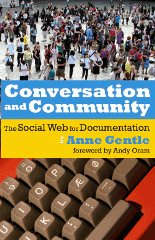Let the conversation begin
 Conversation and Community: The Social Web for Documentation (XML Press, ISBN: 9780982219119) by Anne Gentle provides technical communicators with a roadmap for integrating social media — blogs, wikis, and much more — into their content development efforts. This is critical because, as Anne notes in the preface, “professional writers now have the tools to collaborate with their audience easily for the first time in history.”
Conversation and Community: The Social Web for Documentation (XML Press, ISBN: 9780982219119) by Anne Gentle provides technical communicators with a roadmap for integrating social media — blogs, wikis, and much more — into their content development efforts. This is critical because, as Anne notes in the preface, “professional writers now have the tools to collaborate with their audience easily for the first time in history.”Anne provides overviews of all the major social media concepts — from aggregation to syndication, wikis, discussion, presence, and much more. But it is Chapter 3, “Defining a Writer’s Role with the Social Web,” that will make this book a classic. Here, Anne lays out a detailed strategy for determining whether and how to introduce social media in an organization. Consider this:
It’s important to find a balance between allowing an individual’s authentic voice to speak on behalf of an organization and the requirements of institutional messaging and brand preservation. […] It’s also possible that you are ahead of the curve and need to help others see ways to apply social technologies for the company.
She goes on to explain just how to accomplish these things.
Wikis and blogs each get a chapter of their own, in which Anne discusses how to start and maintain these types of environments.
After reading so much of Anne’s work on her blog, it’s a bit odd to see her writing on paper in an actual book. The feeling that I’ve wandered into the wrong medium is augmented by extensive footnotes, most of which point to web site resources, and the many examples of web-based content (such as videos or interactive mashups). However, it’s likely that the book’s target audience is more comfortable with paper.
Conversation and Community: The Social Web for Documentation provides an excellent introduction to wikis, blogs, forums, and numerous other social media technologies for the professional content creator. There is valuable (and perhaps career-preserving) information about how to develop a strategy for user-generated content that is compatible with your organization’s corporate culture.
If you think that community participation in your documentation is coming soon, read this book immediately. If you think that it’s not coming, you’re wrong, and you especially need to read this book.
Sample chapter (PDF)
[Disclosure: I reviewed an early draft of this book. I have met Anne in person a few times and we have ongoing email and blog correspondence.]



Larry Kunz
Thanks, Sarah. You’re absolutely right when you say that community participation in documentation is coming soon. Ignoring it is not an option.
Or, to play on Anne’s title: This is a conversation we need to have in the community of technical communicators. This book is an invaluable part of that conversation.
Anne Gentle
Thank you Sarah for all your help with this book. Your comments on the early draft were extremely valuable and I appreciate this review!
I probably could write an entire blog entry to talk about the differences between writing a book and writing blog entries. 🙂 But I’d better get started on a good collection of links for people to get out of the book medium and into the footnotes.
Larry, thanks for seeing and mentioning the conversation angle here – I’d love to keep the discussions going wherever we can. Be it blogs, Amazon discussion boards, Twitter, email, wherever you’d like to start talking, I’m listening. 🙂
Betty Prioux
Sarah, thanks for highlighting this book. Many of us out here are wondering how best to use collaborative tools available today in corporate environments to create documentation without losing total control of the content and maintenance/update processes. Anne’s book sounds like a comprehensive survey of this area with lots of possible answers. Time to go order a copy…
Anne Gentle
In addition to my blog and Twitter for discussion, I’ve put together a place to talk about the book on Facebook — here’s a shortcut link: http://bit.ly/disAl8. Would love to see you there! 🙂